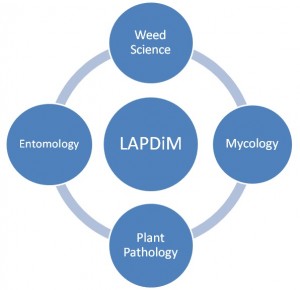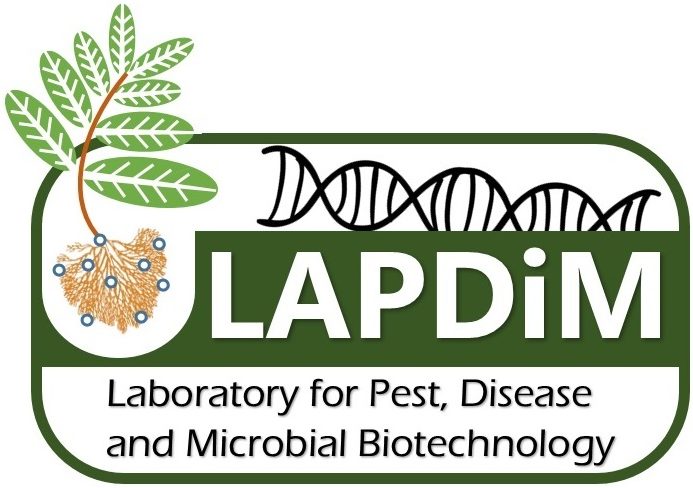Welcome to Laboratory of Agri-Food Pest and Disease Management (LAPDiM) research site. Our current research activities in the laboratory can be broadly divided into four main areas in weed science, mycology, plant pathology and entomology.  1. WEED SCIENCE
1. WEED SCIENCE
Researcher: Assoc. Prof. Dr. Chuah Tse Seng
Characterization of herbicidal activities of plant allelochemical, 2, 4-di-tert-butylphenol, isolated from Pennisetum purpureum for natural and eco-friendly herbicide development
Herbicides have revolutionised weed control in the developed world and developing countries have rapidly adopted their usage. However, the extensive use of synthetic herbicides has been the cause for the evolution of herbicide-resistant weed. Furthermore, some older herbicides are removed from the production fields for environmental, toxicological or economical purposes. Hence, the need for discovery of new natural herbicide becomes obvious to solve the dilemma of the continued demand for herbicides. A previous study has demonstrated that culm plus leaf extract of Pennisetum purpureum was found to be phytotoxic to selected weed species. One of major allelochemicals isolated and identified from the plant extracts is 2, 4-di-tert-butylphenol (DTBP). However, the potential of this allelochemical as natural herbicide for sustainable weed management remain unknown. This study aimed to characterize the herbicidal activity of 2, 4-DTBP. The findings of this research will lead to development of 2, 4-DTBP as natural and eco-friendly herbicide, thus reducing usage of synthetic herbicide and creating better environment for society.
2. MYCOLOGY
Researcher: Dr. Andrew A. Ngadin
A) Potential of saprotrophic fungal from marine and terrestrial environments
Most aquatic pollution is caused by human activities such as aquaculture industries that produced large amount of wastewater and toxic chemicals. The pollution of water has a serious impact on all living creatures, and can negatively affect the use of water for drinking, recreation, fishing, transportation, and commerce. Industrial wastewater treatment normally use chemical compounds to treat the contaminants and discharge of polluted water. However, biological treatment of wastewater provides a more useful alternative when compared to the chemical treatment. This evidence is highlighted by many studies involving the interaction between saprotrophic microfungi species and toxicants in aquatic ecosystem. One of the biochemically important compounds involving in detoxification of pollutants in saprotrophic microfungi is gluthatione s- transferase (GST). Moreover, GST has also been documented to degrade xenobiotic compound and toxicants. The study aims to achieve the following objectives: [1] to identify potential aquatic microfungi with biochemical functions which are resistant to xenobiotic compounds or toxics. This objective could be achieved through microscopic observation of the growth of in-situ treated microfungal. The second objective is to [2] determine the expression level of GST genes in each microfungi that resistance to xenobiotic compounds or toxics through Real-Time Polymerase Chain Reaction. Finally, the third [3] objective is to construct the GST fungal proteins and determine the specific biochemical mechanisms which are involved. From this research, we will be able to identify potential and unexplored aquatic microfungi with detoxification functions which could be applied in bioremediation of wastewater from marine environment particularly from aquaculture industry. In addition, the identified microfungi species could also be used as bioindicator of pollution level in the marine environment, thereby will be useful for future marine pollution monitoring program.
B) Fungal Conservation
Conservation of fungi is a rare public discussion although there are scientists who know that the presence of fungi in the ecosystem is very important. Many people do not even understand the ecological function and biological information related to fungi and their benefits to the natural environment and human population. For this reason, the fungi are rarely included in broader conservation discussions, policy decisions or land management plans. Nevertheless, fungal species are not immune to the threats, both natural and anthropogenic, that put animals and plants species at risk. Fungal species are threatened by loss of habitat, loss of symbiotic hosts, pollution, over exploitation and climate change, but most of the conservation status of the fungi species has not been evaluated. In Malaysia, although more than 3000 fungi species have recorded and reported but to date, there has been no assessment of Fungal Red List. This may be taken as a clear indication that no fungal conservation efforts are being implemented in Malaysia. Hence, to evaluate and acquire red data list, the allocation of funds to carry out the study is very important. Objectives of the study are [1] to register in the International Union for Conservation of Nature (IUCN) Red list. This information will be used as evidence that the fungal in Malaysia also needs to be protected from threats like animals and plants for biodiversity conservation. The finding of this project also will be used [2] to develop policy on the impact or the threat of economic development on the biodiversity of fungi. In realizing this goal, mycologists, economist and the most important is the source of funding are needed to explore and develop appropriate conservation strategies including promoting awareness about conservation programmes in Malaysia as decision makers need comprehensive information on the conservation status and trends of fungi.
Our recent newsletter at Virginia, USA for global fungal Red list: https://www.osgf.org/blog/osgf-winter-conferences
3. PLANT PATHOLOGY
Researchers:
A) Silicon (Si) project
In Malaysia, there is little knowledge on silicon (Si) nutrient application especially under biotic stress conditions (diseases). The objectives of this study are to determine silicon nutrient action at several plant functioning; 1) structural function, as Si increases cell wall resistance and rigidity; 2) protective function, as it induces a resistance to pathogens. This study will provide a better understanding and appreciation of the potential of silicon (Si) to help improve plant growth development as well as potential of Si to control diseases to the same degree as fungicides.
B) Strawberry Rhizosphere Zone Cooling System
The more stressed a root system is the more problems a plant will have both physically and pathologically, and will become increasingly susceptible to pathogens and insects. In this study, we propose of rhizosphere zone cooling (RZC) with a slight of modification to suit strawberry plant to determine plant growth development and quality of fresh produce (strawberries), biomass and yield production. Furthermore, we will observe plant diseases and pests throughout the growing phase. The RZC has a potential to alter the vegetative and reproductive growth of strawberry plants regardless of the hot climate. Therefore, the RZC approach in lowland conditions has a potential to encourage the growth of highland plants.
MSc or PhD opportunities, for any enquiries, please do not hesitate to email dahliasidique@umt.edu.my
4. ENTOMOLOGY
Researcher: Dr. Nur Aida Hashim
